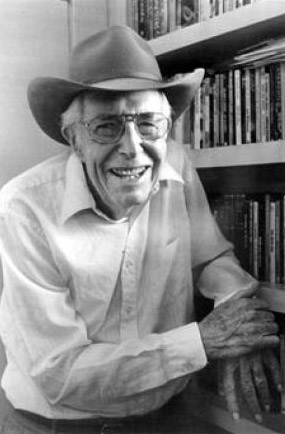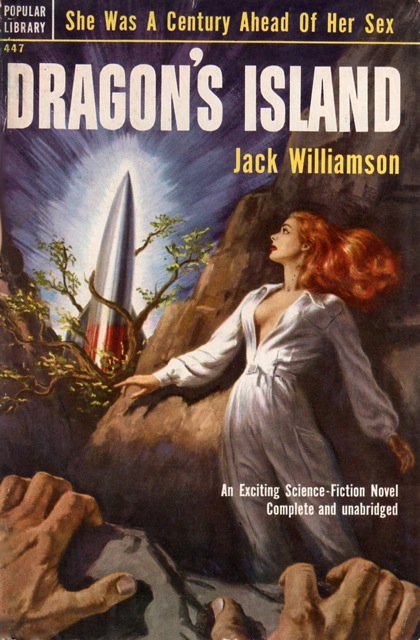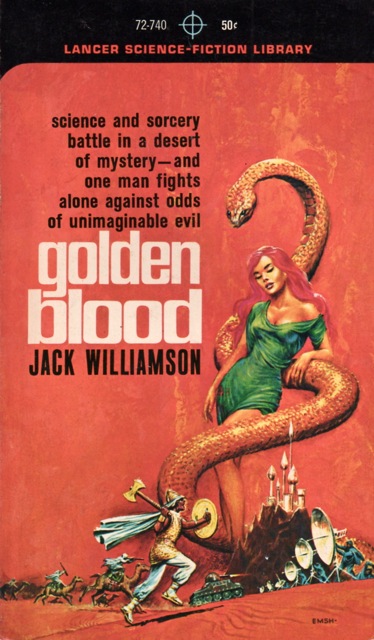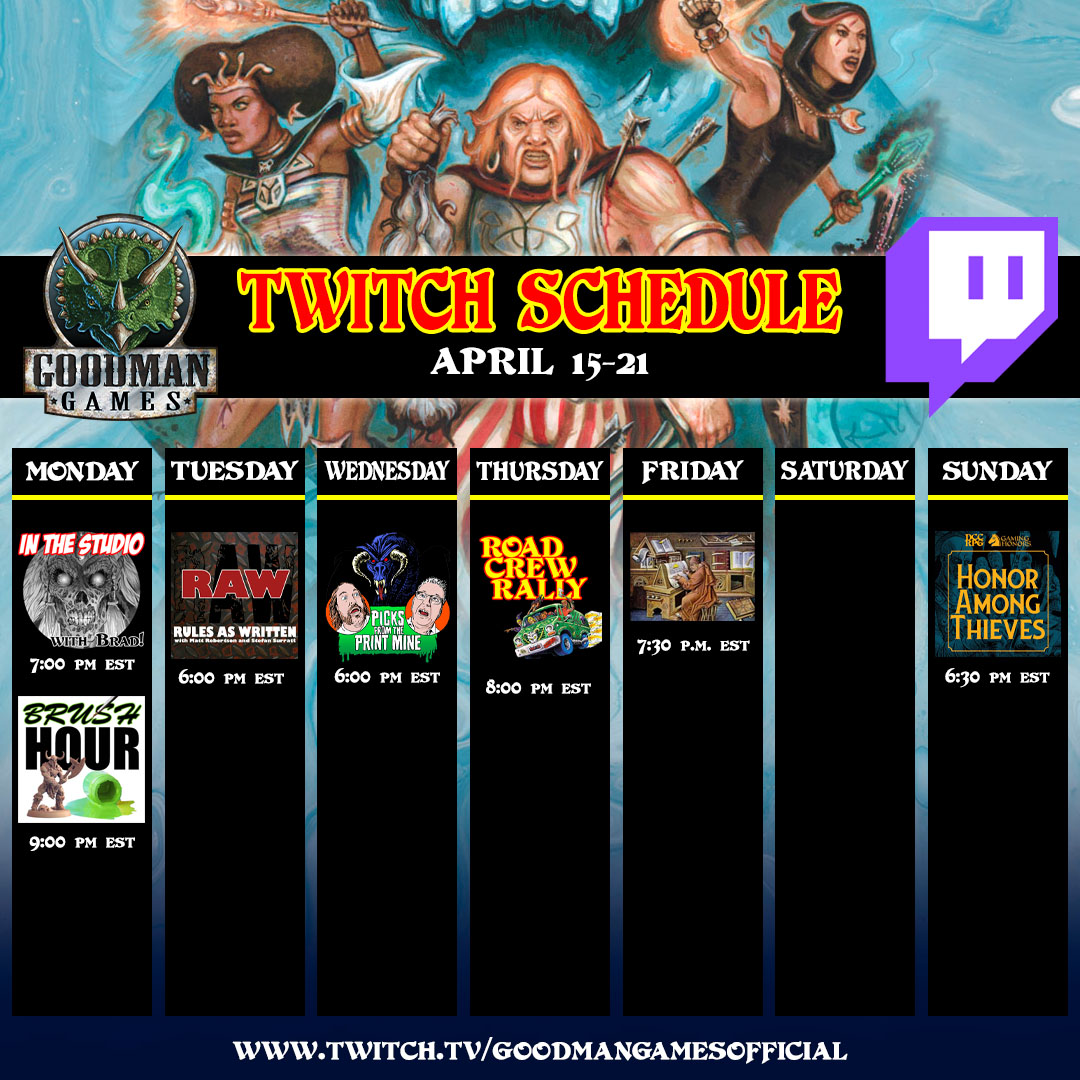Our Adventures in Fiction series is meant to take a look at the writers and creators behind the genre(s) that helped to forge not only our favorite hobby but our lives. We invite you to explore the entirety of the series on our Adventures In Fiction home page.
Adventures in Fiction: Jack Williamson
by Ngo Vinh-Hoi
In the storied list of Appendix N authors, there is one name that encapsulates nearly the entire course of modern American science fiction and fantasy: Jack Williamson. John Stewart Williamson was born on April 29th, 1908 in an adobe hut in what was then still the Arizona Territory. Seeking to better themselves, the Williamson family travelled by horse-drawn covered wagon to New Mexico in 1915, where Williamson recalled that they “homesteaded in Eastern New Mexico in 1916 after the good land had been claimed. We were living below the poverty line, struggling for survival.”
This isolated, hardscrabble existence continued throughout Williamson’s entire youth, but his imagination and inquisitive mind helped him to endure. As he describes, “I did a lot of farmwork—riding horses after a string of cattle, gathering the corn, that sort of thing. Working alone so often like that was naturally pretty boring, so I started creating these endless epics and fictional cycles in which I was the principal character—all this done simply as a way of keeping my mind alive.”
Williamson’s imaginative horizons expanded radically in 1926 when he wrote away for a free issue of the newly-launched Amazing Stories, the first magazine devoted solely to “scientifiction”. It was herethat Williamson first encountered the work of A. Merritt via a reprint of the short story “The People of the Pit.” Inspired by the “color, wonder, the magic of sheer imagination” of Merritt’s writing, Williamson began submitting stories for publication and had his first story, the Merritt-esque “The Metal Man” published in Amazing Stories in 1928.
Williamson eventually found a more naturalistic voice, aided by other literary mentors and collaborators including Miles J. Breuer and John W. Campbell, Jr., the legendary editor of Astounding and Unknown magazines. The most well-known works of the first phase of Williamson’s career are the Legion of Space stories, a star-spanning riff on Alexandre Dumas’ The Three Musketeers with the addition of the Falstaffian figure of Giles Habibula, a reformed master criminal of roguish demeanor and enormous appetites.
During this period Williamson also twice underwent psychoanalysis, an experience that he found very positive for his personal and creative development. You’d be forgiven for thinking the opposite though, given how his reactions to psychoanalysis informed Darker Than You Think, his fantasy-horror tale of a psychic, probability-altering, shapeshifting parallel human species that underlies the legends of werewolves and vampires.
After returning from service during World War II as an U.S. Army Air Corps weather forecaster, Williamson’s writing career reached the second of its high points, despite several long bouts of writer’s block. This is when he re-worked Darker Than You Think, his Seetee stories, and the Legion of Space series for hardcover publication, and also published his most acclaimed work The Humanoids, a novel of robots that were created to ensure human happiness but that eventually attempt to take control of the human race in order to fulfill their Prime Directive.
A lifelong student of science and technology, Williamson is credited by the Oxford English Dictionary with coining the terms if not the concepts of “terraforming” and “genetic engineering” in the 1942 short story “Collision Orbit” and the 1951 novel Dragon Island. respectively. Williamson may have also been the first writer to use the term “psionics” in his 1951 short story “The Man from Outside.”
By the late 1950s Williamson sensed that he was at risk of being overtaken by the rapid pace of scientific and technological developments, so he returned to college at Eastern New Mexico University to pursue his long-abandoned undergraduate studies. In short order he also earned a master’s degree in English at ENMU, became a professor of English and creative writing there and went on to earn a Ph.D at the University of Colorado in 1964. Williamson would remain affiliated with ENMU for the rest of his life and became instrumental in establishing science fiction as a legitimate subject of literary study starting in the 1960s.
Williamson’s academic career slowed his fiction output, but during that time he did establish a long-lasting collaboration with Frederik Pohl, editor of Galaxy and If magazines, eventually producing 10 novels together over a 40-year period. Williamson’s writing career would reach one more peak after his semi-retirement from ENMU in 1977, when he began producing new novels every couple of years, with his last work The Stonehenge Gate appearing a year before his death in 2006 at the age of 98.
Although Williamson is often pigeon-holed as a writer of space opera and hard science fiction, he was also an able fantasist, most notably in his novels The Green Girl, Golden Blood, Reign of Wizardry, and Darker Than You Think. It was important to Williamson for his fantasy fiction maintain “a link with reality in that I am using these fantasy elements as a way of describing real human emotions, motivations, and feelings, though these have been transferred to this fantasy setting. For me, there always has to be an element of human reality to any work of literature or it would be worthless—or at least impossible to read with admiration….At any rate, even when I write fantasy stories, I always try to make an appeal to scientific possibility.”
It may be hard to pinpoint specific borrowings from Williamson’s work in early Dungeons & Dragons, but his concerns with two-fisted adventure, good fellowship, and scientific plausibility are surely an underpinning for Gary Gygax’s generally naturalistic approach to fantasy worldbuilding and adventure writing. One piece of Williamsiana that did enter D&D lore though via White Dwarf magazine #12 and The Fiend Folio are the Grell, the beaked and tentacled flying brains that are a direct homage to the Medusae, the villains of Legion of Space.
If you’re looking for adventure and inspiration, it’s surely worth investigating Williamson’s vast body of work, especially given his clear prose and essentially humanistic and forward-looking worldview.












